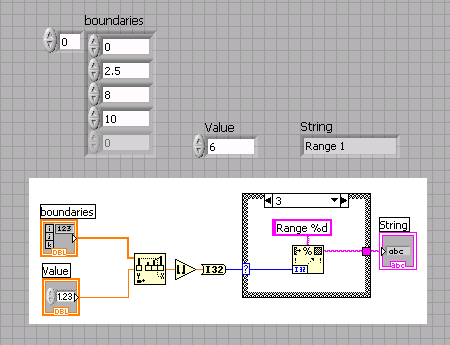- Subscribe to RSS Feed
- Mark Topic as New
- Mark Topic as Read
- Float this Topic for Current User
- Bookmark
- Subscribe
- Mute
- Printer Friendly Page
Basic question on case structures
08-20-2007 06:55 AM
- Mark as New
- Bookmark
- Subscribe
- Mute
- Subscribe to RSS Feed
- Permalink
- Report to a Moderator
I have been using a boolean case structure to handle two different cases (if a measured value is higher or lower then a threshold value), but now I need to add a third case (if the value is in a range in the middle).
I cant figure out how to do this and the LV help and examples dosent give me any ideas, so if you have any examples in store it would be much appreciated.
/Mathias
08-20-2007 07:06 AM
- Mark as New
- Bookmark
- Subscribe
- Mute
- Subscribe to RSS Feed
- Permalink
- Report to a Moderator
08-20-2007 07:29 AM
- Mark as New
- Bookmark
- Subscribe
- Mute
- Subscribe to RSS Feed
- Permalink
- Report to a Moderator
Enum is best way to control case statements. Best if used in custom control type def.
http://zone.ni.com/reference/en-XX/help/371361B-01/lvconcepts/custom_cont_ind_type/
08-20-2007 08:05 AM
- Mark as New
- Bookmark
- Subscribe
- Mute
- Subscribe to RSS Feed
- Permalink
- Report to a Moderator
gchristi1: I looked at the case structure help file and it does explain it well, but i do not understand how to go from having measured values into the enumerated case structure.
So the question is how I based on a numeric value pick a enum value for the case structure.
centerbolt : As far as I can tell the custom controls are about cosmetc changes of controls?
Thanks,
Mathias
08-20-2007 08:30 AM
- Mark as New
- Bookmark
- Subscribe
- Mute
- Subscribe to RSS Feed
- Permalink
- Report to a Moderator
Mathias,
If you go to the next step of creating the strict type def custom control, you can now use the custom control several places in your design and have all those instances referenced back to the custom control. The idea being that if you need to edit the items in the enum, you only have to edit the custom control and those changes will be reflected in all the instances of the custom control in your code.
08-20-2007 08:34 AM
- Mark as New
- Bookmark
- Subscribe
- Mute
- Subscribe to RSS Feed
- Permalink
- Report to a Moderator
The answer of gchristi1 offers you a solution with which you can select a case for different range of numerial values.
If your measured value is floating point, then you can determine the significant decimals and multiply by a factor that makes the value integers.
The integer values can be entered in the case selectors as descirbed by the NI help posted by gchristi1.
Regards,
André
André (CLA, CLED)
08-20-2007 08:40 AM
- Mark as New
- Bookmark
- Subscribe
- Mute
- Subscribe to RSS Feed
- Permalink
- Report to a Moderator
The strict type def definition is primarily for front panel items, to prevent them from changing shape after changing the content. The normal type def defintion is sufficient and allows to resize the control/indicator/constants.
The type def could be a solution but you would have to create a sub VI to convert the measured value into a enum value. The use of the subVI allows you to, when required to add more ranges, change the code required in one place.
Regards,
André
André (CLA, CLED)
08-20-2007 08:59 AM
- Mark as New
- Bookmark
- Subscribe
- Mute
- Subscribe to RSS Feed
- Permalink
- Report to a Moderator
gchristi, that seems to be a good solution for a wider usability, but I will stick to what works as fast as possible right now, I will look closer at it later,
Thanks all for your input.
08-20-2007 10:44 AM
- Mark as New
- Bookmark
- Subscribe
- Mute
- Subscribe to RSS Feed
- Permalink
- Report to a Moderator
If you have multiple ranges, one easy way would be to use threshold array on a sorted array as e.g. shown here. Modify as needed.

(see also http://forums.ni.com/ni/board/message?board.id=170&message.id=232911#M232911)
